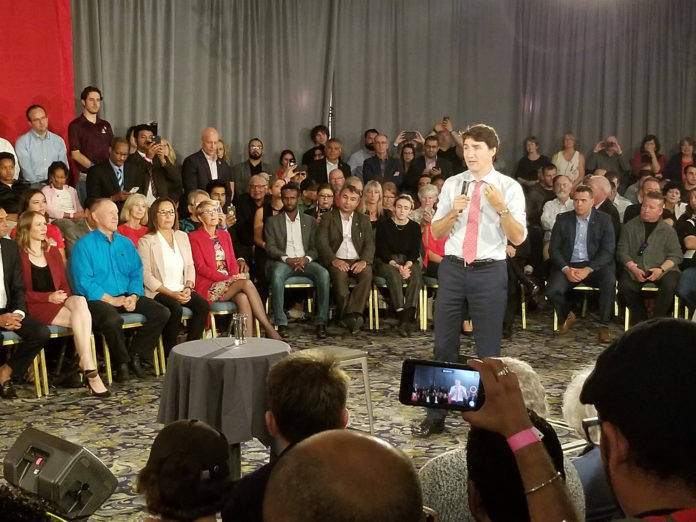
Justin Trudeau survived his first re-election campaign, but he will have to find a way to work with either the NDP, Bloc Quebecois or Conservatives to put forward his agenda after Canada elected a minority Liberal government Monday night.
As of press time, the Liberals were declared as victors in 153 ridings and leading in three more, the Conservatives held 119 seats while leading in two, the Bloc Quebecois had won 32 seats, the NDP had 23 and were leading two more, the Green won three and independent Jody Wilson-Raybould won her riding.
While the Liberals won more seats, the Conservatives earned more of the popular vote. As of writing, the Liberals had earned 33 per cent of the vote and the Conservatives 34.4. Part of that was due to results in Alberta where the Conservatives won an overwhelming majority in all ridings but one.
The NDP earned about 16 per cent of the vote, while the Bloc had just over eight.
Voter turnout as of writing was 56.63 per cent, not including electors who registered on election day, with over 90 per cent of polls reporting.
While Trudeau survived, several prominent members of his party weren’t so lucky.
Longtime Liberal MP Ralph Goodale, who served under both Justin and Pierre Elliot Trudeau, lost in Regina-Wascana to Conservative Michael Kram.
In Edmonton, former cabinet minister Amarjeet Sohi also lost his seat, while Manitoba’s Robert Oulette-Falcon also fell.
All told, the Liberals lost 21 seats and the NDP 14. The Conservatives gained 26 seats nationwide while the Bloc Quebecois swept through Quebec, increasing their count by 22 seats to 32. The Green party added one MP, while the People’s Party of Canada lost its only MP and finished the election with none.
Statistical models had the Liberals and Conservatives deadlocked heading into election day, but the Liberals were able to take many of the battleground seats in the Greater Toronto Area.
They also found support in the Maritime provinces, Montreal and southwestern Quebec.
The party won a pair of seats in Winnipeg and a handful around Vancouver, along with two of the three seats in the territories.
While Eastern Canada was a multi-coloured map with the light blue of the Bloc, dark blue of Conservatives, Red, orange and even one spot of green, the Prairies were a different story.
The Conservatives swept Saskatchewan, winning 64. 8 per cent of the province’s popular vote.
They also won southern rural Manitoba and all of Alberta save for the sole NDP seat in Edmonton, as well as most of Eastern BC. The party earned about 69 per cent of the popular vote in Alberta, with over 1.2 million Albertans marking an ‘x’ beside a Conservative candidate.
Rural Ontario also voted Conservative, as did parts of Quebec and New Brunswick.
Conservative leader Andrew Scheer easily cruised to victory in Regina Qu’Appelle, earning more than 60 per cent of the vote.
After a slow start to their campaign, the NDP was able to recover but did come out of the election with fewer seats than when they started.
While Singh fought a tight battle in Burnaby South, fellow leadership contender Nikki Ashton won in Churchill-Keewatinook Aski.
The NDP also earned seats in Western BC, northeastern Ontario, in the union-stalwarts of London, Windsor and Hamilton and a single seat in Quebec.
They won the only non-conservative seat in Alberta, with Heather McPherson topping Sam Lilly in the Edmonton Strathcona riding, and upset incumbent Oullette in Winnipeg Centre.
The Green Party also had a good day at the polls, increasing their number from two to three.
Leader Elizabeth May won her riding of Saanich-Gulf Islands, while Paul Manly of Nanaimo-Ladysmith will also return to the House of Commons.
This year, though, the Greens elected their first MP from outside of Vancouver Island. Jenica Atwin won the Fredricton riding, beating second-place finisher Andrea Johnson by about three percentage points of the popular vote. She also beat out Liberal incumbent Matt DeCourcey, who finished in third.
Former Liberal MP Jody Wilson-Raybould who was at the centre of the SNC-Lavalin controversy won her seat running as an independent.
It was a less positive day for Maxime Bernier and his fledgling People’s Party of Canada.
The party failed to elect any MPs, with Bernier losing his Quebec-based Beauce riding to Conservative Richard Lehoux. It wasn’t even close. As of press time, Lehoux led by about 4,000 votes.
What it all means is that a likely left-leaning agenda will be pushed through parliament as long as either the New Democrats or Bloc Quebecois agree to prop up Trudeau’s Liberals.
It also means the regional divisions seen during the election campaign are likely to deepen, with a vast swath of rural Canada voting Conservative, but the more population-dense urban areas choosing Liberal or NDP.
However it shapes up, the ruling party will have to make compromises to pass its agenda or risk a non-confidence vote. If such a vote should happen, Canada could face another national election before four years are up.

